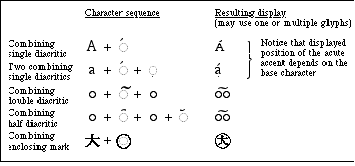Legacy Document
Important: The information in this document is obsolete and should not be used for new development.
Important: The information in this document is obsolete and should not be used for new development.



The Unicode standard defines a combining character as «a character that graphically combines with a preceding base character» and a nonspacing mark as «a combining character whose positioning in presentation is dependent on its base character». A nonspacing mark generally does not consume space along the visual baseline in and of itself.
Similar nonspacing marks have been used in bibliographic standards for some time. Many of these standards are derived from the USMARC set developed by the Library of Congress in the 1960s. In these standards, nonspacing marks precede the base character so they can be handled by the primitive text layout techniques that were characteristic of the 1960s. The MARC sets and ISO 5426 allow one or two combining marks; these sets support many Latin-script languages and transliteration of several non-Latin-script languages. ISO 6937 allows one combining diacritic before a base character and allows only certain combinations of diacritics and base characters.
In ASMO 449 (Arabic), ISCII-88 and ISCII-91 (Indic), and TIS 620-2529 and TIS 620-2533 (Thai), combining marks for vowels, tones, and so on follow the base character. Unicode adopted this approach and extended it to nonspacing marks for Latin, Greek, and other scripts, so that all combining characters could be handled consistently.
The USMARC and ISO 5426 sets included characters for right and left halves of diacritics that span two base characters (these are used in Tagalog, for example). Unicode included these for compatibility, but also included single characters for the full diacritic.
Unicode also includes a set of combining enclosing marks for symbols, such as COMBINING ENCLOSING CIRCLE. Figure B-6 gives an idea of the variety of combining marks present in Unicode:
Figure B-6 Some combining marks present in Unicode

There are other sorts of characters that combine graphically for display, but that--strictly speaking--are not combining characters.
Unicode and some other character sets (such as Mac OS Roman) include a FRACTION SLASH character for composing fractions. A digit (or digit sequence), followed by a fraction slash, followed by another digit (sequence) should be displayed as a single composed fraction.
Unicode also includes a set of conjoining Korean jamos. These constitute the Korean alphabet and are graphically combined into square syllable blocks for display according to well-defined rules (The Unicode standard provides an algorithm for this). This is similar to the process of ligature formation in Arabic or Devanagari (although in those scripts the set of ligatures and the rules are typically more font-dependent); but Unicode also has a set of nonconjoining jamos. Figure B-7 provides examples of the behavior of fraction slash and conjoining jamos.
Figure B-7 Fraction slash and conjoining jamos

In Figure B-6 and Figure B-7 , the character sequences shown on the left side are called decomposed character sequences; they generally correspond to a single displayed text element. Some character encodings may represent that displayed text element with a single character code, in addition to or instead of using the decomposed representation. Single code points for text elements such as the ones on the right side of Figure B-6 and Figure B-7 are called precomposed characters. Unicode includes many precomposed characters as well as combining and conjoining characters that can be used for decomposed sequences; the former accommodate backward compatibility requirements, while the latter are better suited to modern graphics and text processing systems.
As a result, Unicode includes multiple representations (or «multiple spellings») for the same text elements. Multiple representations of the same text elements should generally be treated as equivalent for most text processing purposes. Also, when converting among encodings, there may be multiple representations in Unicode that correspond to a given character in another encoding.